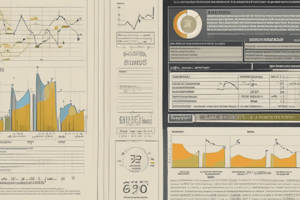Podcast
Questions and Answers
Which of the following best describes the relationship between revenues and cash inflows?
Which of the following best describes the relationship between revenues and cash inflows?
- Revenues can include non-cash transactions. (correct)
- Revenues are always reflected in cash outflows.
- Revenues consist only of sales transactions.
- Revenues are equivalent to cash inflows.
What is represented by the term 'Operating Profit' in the vertical format income statement?
What is represented by the term 'Operating Profit' in the vertical format income statement?
- Net profit after income tax expense.
- Gross profit minus administrative expenses. (correct)
- Total revenues minus all expenses including extraordinary items.
- Revenue minus operating expenses and financial costs.
What does the term 'Extraordinary Revenues' include in financial statements?
What does the term 'Extraordinary Revenues' include in financial statements?
- Income tax returns from previous years.
- Sales revenue generated during regular business activities.
- Revenue from interest or share incomes.
- Gains from grants and subsidies. (correct)
According to the double-entry principle, what must happen when there is a change in an asset?
According to the double-entry principle, what must happen when there is a change in an asset?
In the classification of expenses, which category does 'Salary expenses' fall under in the income statement?
In the classification of expenses, which category does 'Salary expenses' fall under in the income statement?
What does the income statement primarily measure?
What does the income statement primarily measure?
According to the realization principle, when should revenue be recognized?
According to the realization principle, when should revenue be recognized?
Which of the following accurately reflects the calculation of net income?
Which of the following accurately reflects the calculation of net income?
What effects do expenses generally have on owners' equity?
What effects do expenses generally have on owners' equity?
What is the purpose of the Matching Principle in accounting?
What is the purpose of the Matching Principle in accounting?
Under the accrual basis of accounting, when are expenses recognized?
Under the accrual basis of accounting, when are expenses recognized?
Which statement correctly reflects the relationship between net income and the book value of a company?
Which statement correctly reflects the relationship between net income and the book value of a company?
How is revenue defined in terms of its impact on owners' equity?
How is revenue defined in terms of its impact on owners' equity?
What does the equation Total Assets = Total Liabilities + Shareholders' Equity signify?
What does the equation Total Assets = Total Liabilities + Shareholders' Equity signify?
Which of the following combinations correctly defines Net Income?
Which of the following combinations correctly defines Net Income?
In terms of liquidity, which statement is incorrect?
In terms of liquidity, which statement is incorrect?
How does net income impact a company's book value when the net income is greater than zero?
How does net income impact a company's book value when the net income is greater than zero?
Which financial statement primarily reflects a company's profitability?
Which financial statement primarily reflects a company's profitability?
What represents the core equation linking the Balance Sheet and the Income Statement?
What represents the core equation linking the Balance Sheet and the Income Statement?
What happens to a business's liabilities when it experiences a loss?
What happens to a business's liabilities when it experiences a loss?
Which of the following statements about expenses is false?
Which of the following statements about expenses is false?
Flashcards
Income Statement
Income Statement
A financial statement summarizing a company's revenues and expenses over a period of time, showing profit or loss.
Net Income
Net Income
The difference between total revenues and total expenses over a given period. A positive net income indicates profit, while a negative net income indicates a loss.
Revenue
Revenue
The income generated from the sale of goods or services during an accounting period.
Expenses
Expenses
Signup and view all the flashcards
Realization Principle
Realization Principle
Signup and view all the flashcards
Matching Principle
Matching Principle
Signup and view all the flashcards
Revenues vs. Cash Inflows
Revenues vs. Cash Inflows
Signup and view all the flashcards
Expenses vs. Cash Outflows
Expenses vs. Cash Outflows
Signup and view all the flashcards
Accrual Basis of Accounting
Accrual Basis of Accounting
Signup and view all the flashcards
Net Income vs. Cash Flows
Net Income vs. Cash Flows
Signup and view all the flashcards
Double-Entry Principle
Double-Entry Principle
Signup and view all the flashcards
What does the Income Statement show?
What does the Income Statement show?
Signup and view all the flashcards
Business Equation
Business Equation
Signup and view all the flashcards
Shareholders' Equity
Shareholders' Equity
Signup and view all the flashcards
Profitable vs. Unprofitable
Profitable vs. Unprofitable
Signup and view all the flashcards
Liquidity
Liquidity
Signup and view all the flashcards
Profitability
Profitability
Signup and view all the flashcards
Impact of Net Income on Cash
Impact of Net Income on Cash
Signup and view all the flashcards
Balance Sheet and Income Statement Relationship
Balance Sheet and Income Statement Relationship
Signup and view all the flashcards
Study Notes
The Income Statement
- The income statement, also known as the P&L (profit and loss) statement, is part of the Comprehensive Income Statement.
- It's a summary of a company's revenue and expenses over a specific period.
- It measures the company's performance over a time frame.
- It acts as a "film" of the business's activity during the period.
Calculating Net Income
- Net income = Revenues - Expenses
- Net income > 0 means profit, increasing the company's book value.
- Net income < 0 means a loss, decreasing the company's book value.
Revenue
- Revenue is the price of goods sold and services rendered during an accounting period.
- It increases owners' equity.
- It results in an increase in cash or accounts receivable.
- It represents the increase in owners' equity from business operations.
- The realization principle states revenue is recognized when goods are delivered or services rendered.
Expenses
- Expenses are the costs of goods and services used to generate revenue.
- Examples include salaries, advertising, rent, utilities, and depreciation of assets.
- Expenses decrease owners' equity.
- Expenses lead to either a decrease in assets or an increase in liabilities such as accounts payable.
- The matching principle matches expenses to the revenue they generate. Expenses are recognized in the same period as the revenue they helped produce.
Accrual Basis of Accounting
- Accrual accounting recognizes revenue when it's earned and expenses when they're incurred, not when cash changes hands.
- It has two fundamental rules:
- Revenue is recognized when it's earned.
- Expenses are recognized when they're incurred.
Net Income and Cash Flows
- Revenues and expenses are recorded when earned or incurred, regardless of when cash changes hands.
- Revenue is not the same as cash inflow.
- Expenses are not the same as cash outflow.
Income Statement Formats
- Income statements can be presented horizontally or vertically.
- Horizontal format groups expenses by nature (e.g., salaries, interest).
- Vertical format groups expenses by function (e.g., cost of sales, administrative expenses).
The Double-Entry Principle
- Every transaction affecting a balance sheet account (assets, liabilities, equity) also affects another account.
- These effects are inverse, balancing the accounting equation.
- Total assets always equal total liabilities plus equity.
The Business Equation
- Assets = Liabilities + Shareholder's Equity
- Assets = Liabilities + Share Capital + Retained Earnings
- Assets = Liabilities + Expenses + Revenues
Studying That Suits You
Use AI to generate personalized quizzes and flashcards to suit your learning preferences.



